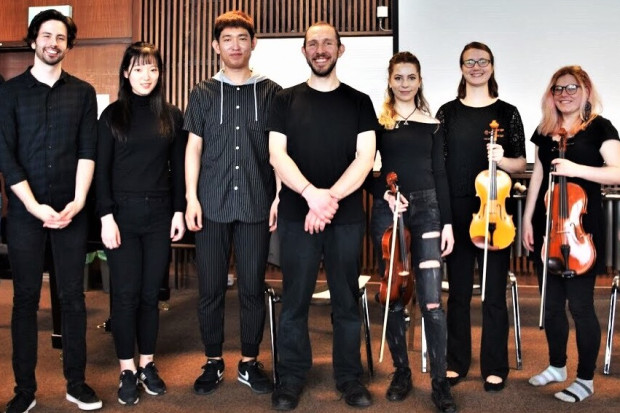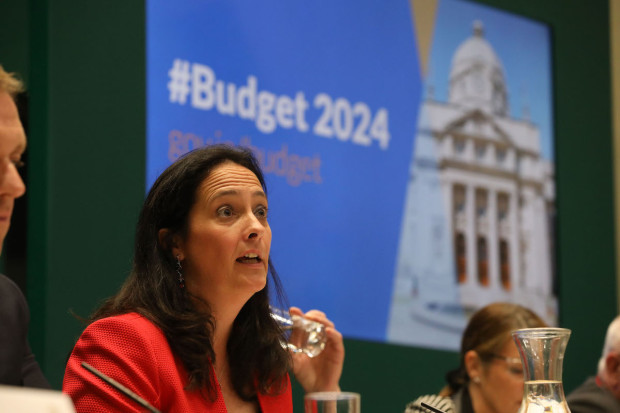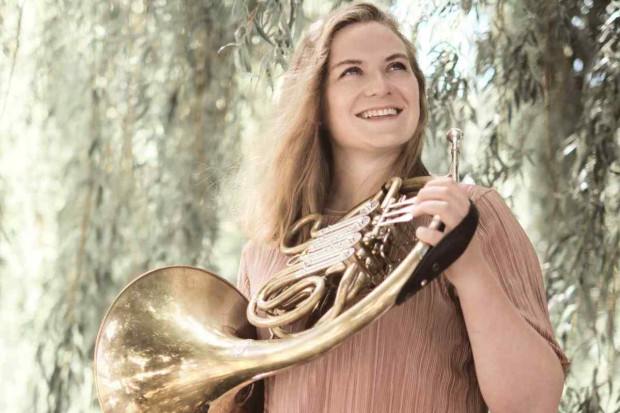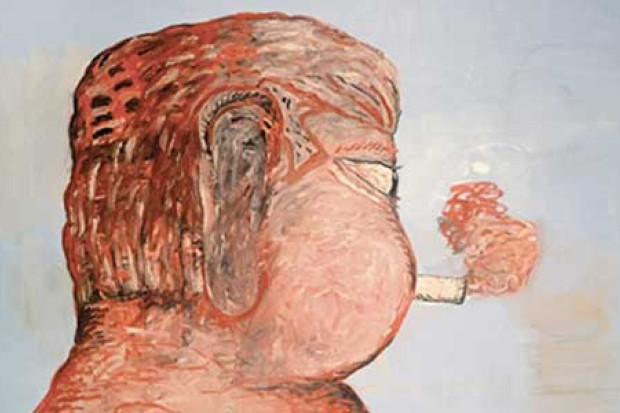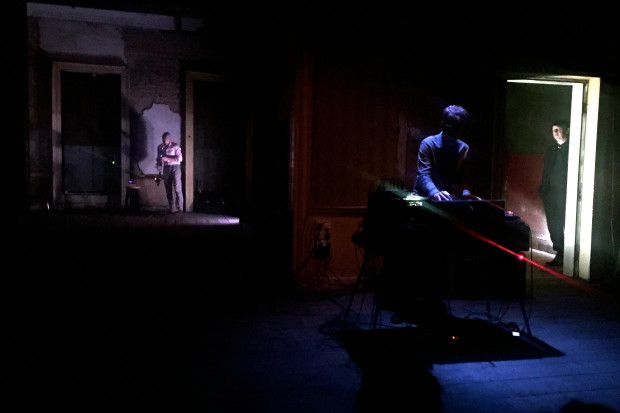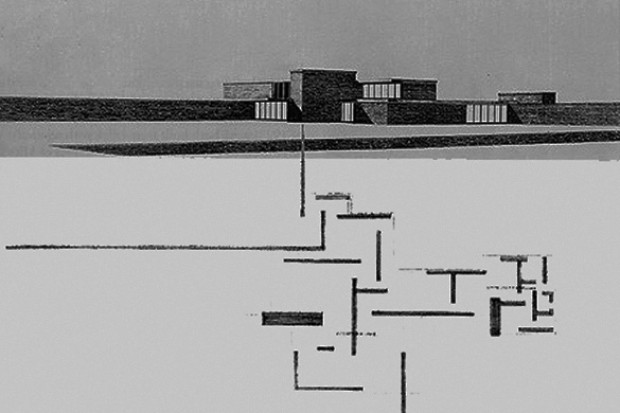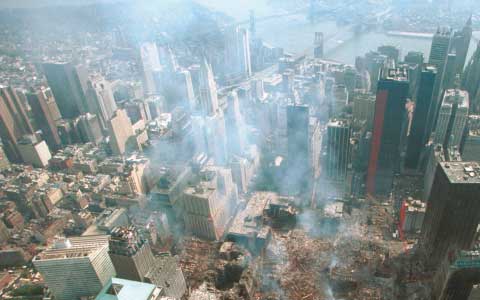
Empty Space
Just a few months after the devastating attack on the World Trade Centre on 11 September 2001, the composer John Adams was asked by the New York Philharmonic if he would compose a memorial piece for the victims. At first, it might have appeared a simple matter: in a country in a state of shock, in a city attacked and traumatised, a classical orchestra asks a high-profile composer to do what music has long done at times of loss and grief: to provide a ritualised, coherent shape for the flux of human emotions. But there was more to it than that: here was a commission that asked if music in the classical tradition can still be vital to the public history of the nation.
John Adams, an American composer whose work is among the most played in the world, was an obvious choice. Adams is the antithesis of the solitary composer tortured by doubt about the value of music; he is not baffled by the need to choose from among the multiple musical dialects competing for attention, nor is he intimidated by the intellectual prestige of the twentieth-century avant-garde. Insofar as anyone can be, Adams is a popular composer with a commitment to the public realm and with confidence in the value of his own work. This was not a commission that Adams could refuse, as he writes in his autobiography, Hallelujah Junction:
I recognised that the request for this piece was virtually a call to civic duty and that the orchestra was reaching out to an American composer, asking him to give voice to complicated, communally shared emotions…
At this point, some might have feared the worst. Here is a composer with a sense of civic duty responding as a loyal American citizen to his nation’s call at a time of crisis and, since this crisis was brought on by a deliberate attack on the symbolic centre of American economic power and a less successful attack on the symbolic centre of its military power, the result might be the musical projection of the dangerously blinkered world-view of George W. Bush and those around him. But the Adams case is much more interesting than this. Though he was and is the most popular of living American composers, with a history of writing on public subjects going back to his opera Nixon in China (1987), Adams was in fact quite torn in his feelings. He had no idea what kind of piece he could write that would be adequate to the occasion; and he feared that his reputation as ‘a composer of “current event” operas’ would arouse suspicion or be used against him in the cultural world.
Part of the problem was the gap between Adams’ own political sense and that of many in his audience:
I was concerned that my own private thoughts about the nature and reasons for the September 11 terrorist attacks might fall foul of the lockstep, unquestioning patriotism that the Bush administration was so successfully cultivating throughout the country.
Adams had a history of dissent from right-wing American opinion on foreign policy – and the Middle East in particular. Curiously, at the time of the 9/11 attacks, Adams was in London for rehearsals of the film version of The Death of Klinghoffer, his most controversial work. This opera centres on the real-life hijacking of an Italian cruise ship, the Achille Lauro, in 1987. The ship was boarded in Egytian waters by four heavily armed members of the Palestine Liberation Front who intended to use the mainly elderly passengers as hostages in order to force the release of Palestinian prisoners. In the course of this hijacking that never went according to plan, Leon Klinghoffer, a sixty-nine-year-old, wheelchair-bound Jewish passenger, was shot and dumped overboard. In taking on this subject, but using a libretto (by Alice Goodman) that granted dignity and sympathy to Palestinian as well as to Israeli experience, Adams showed that he could deliberately step out of the American mainstream and expose himself to misunderstanding and vilification. While describing Americans’ solidarity with the Jews of the world as ‘a noble thing’, Adams also found himself asking ‘why the mainstream American media inevitably presented the Palestinians as delusional and self-defeating, unfailingly committed to nihilistic violence’. He felt that there was a glaring contradiction between the values the United States proclaimed and its actions, just as there was a contradiction between the hopes that Israel represented on its foundation and its actions on the ground.
As he responded to the New York Philharmonic commission, Adams also had in mind how the British had responded in musical terms to 9/11. His own Short Ride in a Fast Machine, having previously been dropped from a concert programme because it coincided with the death of Princess Diana, was dropped from the Last Night of the Proms, this time in favour of the slower Tromba Lontana for orchestra (1986). Almost inevitably, Samuel Barber’s Adagio for Strings was added to the programme. In this context, Adams found the piece too ‘heart-on-sleeve’ compared to the ‘noble simplicity’ of Elgar’s ‘Nimrod’ from the Enigma Variations. Adams recognised the effectiveness and attractiveness of the Barber piece but it didn’t measure up to what he was looking for (even if this might appear hopelessly old-fashioned to some): music with a noble, or elevated, or sublime dimension. Most disturbing to Adams was that America – at least in the eyes of the BBC – did not have ‘a single orchestral work that could satisfy the need for collective emotional experience that a seriously traumatised public maintained in those jarring days after the attacks’. Though he acknowledged the quality of some short, intimate American works like Ives’ Unanswered Question, Copland’s Quiet City and of course the Barber Adagio, his disappointment was clear:
In our canon of more than a century’s worth of American orchestral music, there apparently was not a single work that had the power or pride of position to answer to the needs of that peculiar moment in history…. We could not contribute anything on the level of a grand public statement of communally shared hope and idealism such as Beethoven or Mahler would satisfy…. Was this simply a fault of history? Were the kind of Enlightenment ideals of Beethoven or the yearning spiritual quests of Mahler simply relics of the past, no longer possible in our more ironic and painfully self-conscious contemporary climate?
At the core of Adams’ disquiet were two things: that America seemed unable to rival centuries of European music when it came to spiritual depth; and, more broadly, that modern art may have lost the capacity to speak to the world in a sublime mode. This is not the kind of question that lends itself to clear answers. It may be, however, that Adams is temperamentally out of key with the true modern sublime, which – as in Morton Feldman’s Rothko Chapel – tends to be quieter, or more indirect and elusive, than its nineteenth-century predecessor. Be that as it may, the feeling that American music was inadequate was a challenge to Adams’ whole orientation as a composer. Adams is not a contemporary composer who just happens to be American; he is, in the fullest sense of the term, an American composer. There is an almost archetypal quality to the shape of his career: raised in New England, by parents with a background in jazz and musicals; finding his way to Harvard, which could then be described as an outpost of the European avant-garde; divided between his academic studies and the excitement and symbolic importance of rock music, protest politics and hippiedom; undergoing the liberating and distinctly American influence of John Cage; making the journey westward across the continent to California, where he settled.
Adams’ journey to the West Coast in the 1960s, his switch from the Atlantic to the Pacific, was a conscious embrace of American experience and values, and it fits into a long-established pattern. American cultural independence had to be fought for long after its political independence, with the cultural elite under the sway of European forms and voices. In literature, Walt Whitman’s energetic projection of a truly American voice was foundational: his choice of open form; his embrace of American lives and landscapes; his embrace of democracy; his ‘Song of Myself’ being also, or even primarily, a song of the self-discovering nation. But even Whitman did not obliterate the Anglo-centric or Euro-centric cultural strain embodied in Henry James and other sophisticates. Some decades later – the arts do not march forward tidily in step for the convenience of cultural historians – Charles Ives, with far less public echo, performed a similar foundational gesture for classical music in America when he allowed the inherited musical language to be raucously invaded by American sounds and dialects.
The John Adams of 2001 was therefore very much in the American grain, still true to his rejection of the European avant-garde. He regretted the gap that opened up between composers and the general public in the twentieth century. He regretted the loss of the expressive powers inherent in tonality. He was conscious of – and positively admired certain aspects of – jazz, the American musical (the inheritor of the role of opera in the nineteenth century), American song, rock and pop. On the other hand, though he had moved west and looked out on the Pacific, he remained a New England idealist: Whitman and Dickinson meant more to him than the Beats, and he believed that music should deal with fundamental human concerns and thus engage with its audience. He was confident and optimistic in his general approach, with several large-scale projects already behind him and he clearly did not believe that irony was the supreme value.
This was not the orchestra’s first attempt at dealing with the tragedy. Musicians from the Philharmonic had already been to Ground Zero to play for and console the workers, the bereaved and the local inhabitants. The orchestra, under Kurt Masur, had also performed the Brahms Requiem in Avery Fisher Hall and, according to Adams, ‘brought a sense of consolation and momentary tranquility to a grateful audience, reminding the world that classical music has the ability to speak to the deepest parts of our spirits that other forms of music are powerless to reach.’
Adams sees a special, elevated function for classical music. This consolatory and spiritual function is not one that many in either the European or the American avant-garde would identify with. Though if art is seen as responding to communal trauma, it cannot be spoken of in purely technical or formal terms, as a domain in which painting is about surfaces, music about the formal manipulation of sound, poetry about language itself. In doing so – despite being a democrat at heart – Adams rejects both the post-modernist and the left-academic mantra that all cultural forms are equally valid, a view often accompanied by an identification of elite forms as cultural embodiments of racist, imperialist or ruling-class ideologies. So he was genuinely disturbed that both American music and his own career might be found wanting when measured against a large-scale human event like 9/11.
There were special difficulties with this commission: images of the collapsing buildings and of the dust-covered survivors fleeing the scene were seared in public memory; to attempt to match or amplify such scenes in music could only be ‘an exercise in the worst possible taste’; meanwhile the process of turning the event into manipulable political kitsch and creating a sense of decontextualised American victimhood was already underway.
As Adams got down to his task, it was on the intimate effects of the event that he found himself working. He used the names of the missing, the hand-written signs left by desperate family members and simple anecdotes from a column in the New York Times to form the basis of a text. He recorded the sounds of the city at night; combined in his mind with the blizzard of paper fragments that floated eerily groundwards in videos of the day, the sounds helped him to conceive a texture. Yet despite his longing to work in a sublime mode, despite his feeling that America had not yet produced a work to match the masterpieces of the European classical tradition, Adams ended up renouncing his own grandiose ambitions; in fact, in On the Transmigration of Souls he would produce a work very much on the scale and in the register of Ives’ Unanswered Question or the works of Barber and Copland already mentioned. It was quite a tentative statement of the American sublime – and harsher critics would accuse the work of falling into the very sentimentalism that he had wished to avoid, particularly in going beyond the listing of victim’s names and quoting directly from the messages.
All the same, it seems that Adams has identified a wound in American culture and in the Western classical tradition. Believing that the modernist avant-garde has lost touch with the world, that there should not be a divide between composer and public, that art should speak to the great human and political questions of the day, that the sublime should be possible, he has done his best to remove himself from the avant-garde, to reach out to the public and to tackle large-scale subjects.With his New England idealism and his essential optimism, Adams has certainly avoided what the philosopher Karsten Harries once called ‘sour kitsch’ (the glib ironies of those modern artists whose negativity or desire to shock is a matter of lightly adopted fashion rather than an inescapable part of a personal quest). The broader question remains: can modern music measure up to Beethoven and Mahler in at least gesturing towards the transcendental or the sublime? Or maybe the question itself is nonsense, to suggest that the sublime is a form of bourgeois cultural self-inflation and that the artist’s only concern should be with the formal demands of the material. The strange thing is that the modernist pursuit of purely formal values is itself often undertaken with an almost religious devotion – and in fact, much of the great art of the twentieth century is less purely formal than its propagandists would suggest. Within what can broadly be termed post-modernism, there is no space for the transcendental: the artist is seen as a manipulator and combiner of all available elements and languages. As a philosophy of art, however, post-modernism is without a driving force, encouraging complacency, surface innovation and a culture of display.
The Adams of 2001 had that driving force. He did not quite succeed in realising the American sublime of which he dreamed – perhaps because his almost engineered control of every element in his compositions runs counter to the grasping after the transcendental – but who knows now in what composer, American or not, the hunger for the sublime is at work?
There are features of human life that persist across time and cultures. No matter how brilliantly religious, transcendental, idealistic or communitarian values are questioned or undermined, human beings continue to demand ritualised expression of the values or aspirations by which they believe that they live and die.
John Adams’ autobiography, Hallelujah Junction, is published by Farrar Strauss and Giroux in the United States, and by Faber in London. us.macmillan.com/hallelujahjunction
Published on 1 August 2010
Barra Ó Séaghdha is a writer on cultural politics, literature and music.










